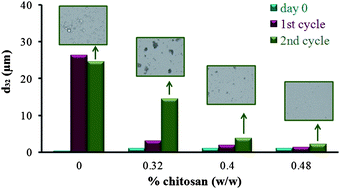Oil-in-water emulsions (10% w/w n-tetradecane) were prepared at pH = 5.7 by using, as surface active agents, electrostatically formed complexes of sodium stearoyl lactylate (SSL) at a concentration of 0.4% (w/w) and chitosan (CH) in a concentration range between 0 and 0.48% w/w. The use of complexes in emulsions with a low concentration of CH (<0.24% w/w) resulted in highly flocculated systems; instead, with increased level of CH, the emulsions had a smaller average droplet size and exhibited greater stability during storage. Emulsions stabilised by SSL/CH complexes showed non-Newtonian flow behavior with pronounced shear thinning. Among all formulations studied none showed a gel-like behavior since in all cases the G′ (storage modulus) was lower that G′′ (loss modulus). Adsorption kinetics of pure SSL and SSL/CH complexes to the oil/water interfaces were evaluated using an automated drop tensiometer (ADT). Even though complexation of SSL with CH resulted in a delay of the adsorption of the surface active species at the oil/water interface, the inclusion of the polysaccharide resulted in substantially improved interfacial properties as indicated by a significant increase of the dilatational modulus. Furthermore, the enhanced interfacial properties of the emulsion droplets resulted in improved stability against freeze–thaw cycling. The results of this study may facilitate the development of frozen food products such as desserts with an ameliorated stability and favorable sensorial characteristics.

You have access to this article
 Please wait while we load your content...
Something went wrong. Try again?
Please wait while we load your content...
Something went wrong. Try again?


 Please wait while we load your content...
Please wait while we load your content...